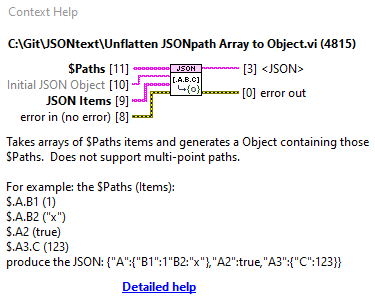-
Posts
1,986 -
Joined
-
Last visited
-
Days Won
183
Content Type
Profiles
Forums
Downloads
Gallery
Everything posted by drjdpowell
-
Can you give a more specific question?
-
Not necessarily, but it is trickier than it looks because of those "multipoint paths" that unflatten does not support. A path like $.a.[new,old].b[4].c.d, for example. If all paths were straightforward like $.a.b.c.d then it would be easy. Although I use JSON for configuration, I'm not using it in the same way you are doing, so it hasn't motivated me to solve this issue. Sorry.
-
See if "Unflatten JSONpath Array to Object" will do what you want. It will create the extra levels if needed.
-
That vipm package seems to have gotten corrupted somehow. I'll contact NI about it. In the meantime, try getting it from here: https://forums.ni.com/t5/JDP-Science-Tools/Out-of-Memory-Error/m-p/4335019/highlight/true#M156
-
Can you try forking the repo? Then making a pull request? I only have a free Bitbucket account and there is a limit on how many people I can add to my repos.
-
I'm afraid I don't have an example. I did once prototype a version where I swapped out the flattened message format for one that used JSON (I recommend JSON as an easy, reliable format to go between languages).
-

Where do y'all get your (free) artwork for UI elements?
drjdpowell replied to David Boyd's topic in User Interface
I use the "Advanced PNG Export" feature of https://pictogrammers.com/library/mdi/. This allows some customisation of icon (size, colour, transparency, border) before downloading. -

Where to put settings modules in my DQMH program?
drjdpowell replied to Nokaroa's topic in Application Design & Architecture
Why are you making Setting modules at all, rather than just having the other modules just read the INI file directly? This seems very over complicated. -

Program architecture
drjdpowell replied to Francois Aujard's topic in Application Design & Architecture
Quite a lot of good architectures are based on using messages between semi-independent modules, with the modules being based on a standardized template. There are a few such "frameworks" publicly available via vipm.io that you could look at. Mine is "Messenger Library", which has some instructional videos. -
I've long thought the Event API has bad naming. If the Event Reg Refnum was called "Event Queue" and the User Event was called "Event Generator", then it would be easier for people to understand it.
-

Ethernet connection with LABView is insufficient
drjdpowell replied to Михаил Бабаев's topic in LabVIEW General
Maybe if you posted what device you are trying to talk to, and perhaps pointed to the manual, you might get better help. -
Did you do the Write? It only outputs on Write. I am considering having the Read write the Template, as it is confusing to have an empty file untill the Write happens.
-
Here is the Issues lost: https://bitbucket.org/drjdpowell/pq-labview/issues?status=new&status=open I am not actively working on this project, but it might be the case that the PQ dll used by the library needs updating.
-
Re the main issue, this seems to be my misunderstanding about how Savepoints work (as distinct from BEGIN and ROLLBACK). Here is a relevant discussion. From that discussion, I see I should, instead of "ROLLBACK TO <Savepoint>" I should do "ROLLBACK TO <Savepoint>; RELEASE <Savepoint>;" Issue 22
-
As an aside, you should look into the Upsert clause, which allows doing INSERT or UPDATE in a single SQL statement. Also, note that you don't need savepoints about a single transaction (all single statements are their own transaction, and either succeed or rollback automatically).
-
Hi @mwebster, Can you upload an example showing this problem? Something is wrong somewhere, as a Savepoint outside of an open transaction should behave the same as Begin-Rollback, to my understanding.
-

Including solicitation of interest from potential acquirers
drjdpowell replied to gleichman's topic in LAVA Lounge
This appears to be a pretty standard "hostile takeover" attempt, complete with all the usual things like a "poison pill" defence, and an appeal to shareholders to set up for a "proxy fight". Noone in the corporate world thinks any less of Emerson for doing a very normal business thing. -

Including solicitation of interest from potential acquirers
drjdpowell replied to gleichman's topic in LAVA Lounge
The market presumable thinks the offer will be accepted, possibly at a higher price. -
Just to second ShawnR's suggestion to look for documentation on the underlying communication protocol. Multiple times I have found poor quality LabVIEW libraries just use better quality communication protocols underneath, and I just implement that protocol with my own library.
-
NI is working on gRPC and LabVIEW. I am trying to give them feedback on their Github page. In particular, I think they are going the wrong way in trying to create a Scripting-black-box solution rather than a simpler gRPC Library, and that this is a major danger to the project. gRPC looks like it could be important, and we have a stake in making this project successful. If anyone else would like to comment on this, please see https://github.com/ni/grpc-labview/issues/208
-
Why are you using Finite Samples in a cycle, rather than Continuous Samples?
-
Your doing it in the UI thread (that would have been my number one guess). Switching threads is one of the few things that can be multi-millisecond expensive. Switch the Call to "any thread". Edit: actually, even a thread switch shouldn't take 40 milliseconds, but give it a try anyway.
- 5 replies
-
- 1
-

-
- labview
- memory management
-
(and 1 more)
Tagged with:
-
Move block is way faster than than that. Can you post an example VI showing how you are calling it?
- 5 replies
-
- labview
- memory management
-
(and 1 more)
Tagged with:




